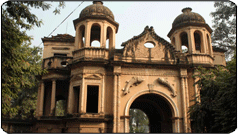Sikander Bagh
The Sikander Bagh crossing near N.B.R.I. (National Botanical Research Institute) is today a place where all traffic comes to a grinding halt, because of the enthusiastic road widening operations. Engrossed with the difficulty of manoeuvring through the jam, one hardly realises the importance of the site, where the fiercest of the battles of the 1857 conflict took place on November 16, which left nearly two to three thousand of the Indian freedom fighters dead, fighting against the English and Sikh troops of the British East India Company.
Sikander Bagh was also the place where the valour of women soldiers of Begum Hazrat Mahal, the leader of the rebellion against the British, came to light. According to an eye witness, Sergeant William Forbes Mitchell, there was a peepultiee under which a number of jars of cold water were placed and soldiers used to go there to quench their thirst. Just as the fighting ceased, bodies of the British soldiers lying dead at a particular spot under the peepul tree, attracted the attention of Captain Dawson. After examining the wounds, he discovered that in every case the man had been shot from above. He then called a soldier, Wallace, to look and see if he could find anyone on top of the tree. Wallace spotted the person and loading his Enfield rifle fired. Down came the body, dressed in a red jacket and pink trousers, the top bursting open revealed that the sniper was a woman. When Wallace saw this, he burst into tears exclaiming, "If I had known it was a woman, I would rather have died a thousand deaths than have harmed her".
The Identity of the woman could not be established but after Independence (in 1957) a monument with a bust of this 'unknown heroine' was erected at the site. A memorial stone (earlier) erected by the British for their soldiers killed in the conflict also marks the place where their bodies had been found at a breach in the wall, near the mosque in Sikander Bagh.
Sikander Bagh was a well laid garden of Wajid Ali Shah, the last King of Awadh, which had been constructed for his favourite wife Umrao, titled Sikander Mahal around 1847, soon after his coronation. She was an extremely beautiful woman and Wajid Ali, when he was the crown prince and heir-apparent, was enamoured by her beauty and composed romantic couplets in her praise.
To celebrate the advent of Basant (spring) a mela (fair) was held in the capital annually [since the reign of Ghazi-ud-Din Haider]. Prince Wajid Ali added to it a drama called rahas, a story of a jogi (mendicant) that was staged at Qaiser Bagh. People from all walks of life participated in the mela which used to last for five days where every one was required to wear basanti (yellow) garments.
On the last day of the mela, Wajid Ali, affectionately addressed as Jaan-e-Aalam, acted as jogi and appeared before his subjects in saffron coloured robes with a female actor as his jogan. Umrao alias Sikander Begum was usually selected for the female role to appear as jogan. Later, when she married and entered into nikah with the King, her title of Sikander Begum was upgraded to Sikander Mahal.
Built at a cost of over five lakh, Sikander Bagh was spread over an area of 187 square metres. It contained a Summer palace and a wooden pavilion along with a small mosque within its enclosure, which was high walled with three lofty gateways on three sides, one of which faced the river Gomti. The walls were made kangoorey-daar with festoon-like concave depressions at regular intervals all along the boundary (some of which is extant). Only one of the three gateways remains today (facing the Rana Pratap Marg) because the rest of the structures of Sikander Bagh were bombarded during an exercise of wanton destruction by the British, for removing such structures that served as scars of the rebellion against them.
The Sikander Bagh gateway with the 'pair of fish' motif of the Nawabs is a queer, hybrid structure that has distinct features of Indian, Persian, European and Chinese architecture in the form of arches, chhattri, pediments, Corinthian pillars and pagodas, all at one place. However, we are very fortunate in having preserved on its inside, frescos with very delicate foliage designs akin to the Chikan embroidery of Lucknow, beautifully executed by the Court painter Kashi Ram. Some fine art-work can also be seen on the borders, below the canopies, the chhattries and pagodas.
King Wajid Ali Shah specially conferred a khillat and presented a robe of honour to the Court painter Kashi Ram on the completion of Sikander Bagh.
Source:
Hindustan Times, City Scan, A Time in History
Wednesday 25.3.1998 — Solemn reminder of the valour of an 'unknown heroine' of 1857

